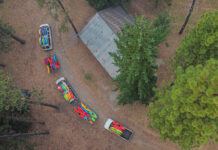I know the river running season is drawing to a close when I can see my garage floor. To some, this would sound like good news, but it always comes with a tinge of sadness. It’s the same kind of sadness that comes while marveling at the beauty of October falling leaves. It marks the end of a season. There is satisfaction, some sense of relief, and a little feeling of loss for what is gone. But there is also contentment in knowing my time was well spent.
From mid-May to early October, my garage floor is ground zero for repeated packing and unpacking for guiding trips or my private adventures. The back wall is all bikes; the left side fly fishing rods, nets, waders of all sizes, and rain jackets; the right side is a drying line for wet kayak gear, paddles and throw bags. Meanwhile the middle is a disorganized stack of tents, sleeping pads, various sized kitchen boxes and drybags.
Out front the trailer holds my raft with the rowing frame that goes on or off depending on the day, plus a jumble of kayaks, both plastic and inflatable, and two canoes. And then there is the stuff that stays in the truck for the full six months. Satellite communicator, power packs, a cooler I had to mortgage my house for, sunscreen and bug spray, river shoes, and assorted hats and sunglasses. All told, everything it takes to guide a fly fishing trip, teach kayaking and take a family on a multi-day. All told, the tools of my craft and a way to make a living. All told, a small mountain of gear I cannot do without.
English designer and poet William Morris is a giant when looking back on Victorian-era history, at the close of the first industrial revolution. Morris was a founding figure in the Arts and Crafts movement of this era, a design style that emerged in response to the grime of the industrial revolution masked by what he perceived to be gaudy, ornate and useless fashion of the day.

Arts and Crafts grew beyond style to become a social movement, focused on craftsmanship, simplicity and anti-industrialization. Morris believed in neither luxury nor cheap trash. This movement was influential, inspiring architecture and design for half a century, until replaced by Modernism in the 1930s.
Morris’ most enduring legacy is perhaps this line, supposedly quoted from a public lecture in 1880: “Have nothing in your houses that you do not know to be useful, or believe to be beautiful.” This line has been abused by many over the ages, used to justify consumerism and an attachment to stuff. This could not be further from Morris’ intent.
For Morris, beautiful was equated with simple, refined, useful and living art. Our things were meant to be used. Our things were meant to contribute to a way of life that in itself builds the beauty of which he spoke. Our things are supposed to be the tools to live a good life. You can see, I expect, where I am going with this.
Much of the great gear pile in my garage, and now being put away for winter, would qualify under Morris’ definition of useful and beautiful. Our outdoor gear tends not towards ornamentation but simplicity and functionality. The best of it, the items we go-to year after year, likely have some innate crafted beauty to them. My canoe paddle, my 20-year-old fold-up backpacking stove, the machined pulleys in my pin kit, and the reels on my fly rods make me marvel.
They are graceful in design, undeniably utilitarian, yet a joy to use, hold and look at. As an end in and of themselves, they are useful. But more importantly, as a means to an end, they enable us to spend time on rivers. They enable our recreation and an opportunity to create. They are beautiful tools; tools building a type of life valuable and worth living.
Jeff Jackson is a professor at Algonquin College on the banks of the Ottawa River.
Gear is like a gas—it will expand to fit the available space. | Photo: Cristin Plaice








